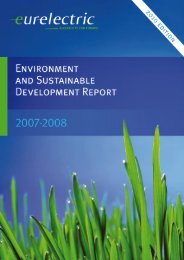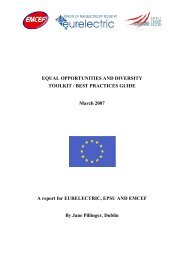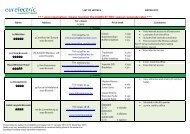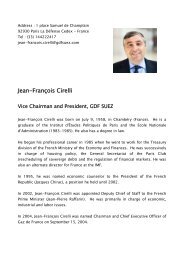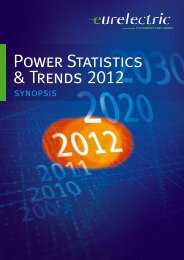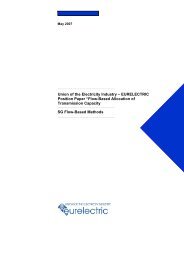Hydro in Europe: Powering Renewables - Full Report - Eurelectric
Hydro in Europe: Powering Renewables - Full Report - Eurelectric
Hydro in Europe: Powering Renewables - Full Report - Eurelectric
Create successful ePaper yourself
Turn your PDF publications into a flip-book with our unique Google optimized e-Paper software.
1. INTRODUCTION<br />
<strong>Hydro</strong>power is a mature and cost-competitive renewable energy source. It plays a key<br />
role <strong>in</strong> today’s electricity mix. As a multifunctional technology, it is <strong>in</strong>dispensable to our<br />
electricity system, and will be even more important tomorrow.<br />
<strong>Hydro</strong>power is situated at the crossroads of different policies, from water<br />
management to electricity generation or other environmental policies. Already today<br />
hydro power tries to balance these sometimes conflict<strong>in</strong>g objectives.<br />
The importance of a generation technology for the overall system depends ma<strong>in</strong>ly on<br />
its capability to stabilise fluctuations between demand and supply. <strong>Hydro</strong>power<br />
already contributes to balanc<strong>in</strong>g these differences – a function that will be even more<br />
valuable <strong>in</strong> the future.<br />
Major changes ahead <strong>in</strong> the <strong>Europe</strong>an electricity market<br />
<strong>Europe</strong>’s electricity landscape is undergo<strong>in</strong>g profound changes, l<strong>in</strong>ked to the aim of a<br />
more renewable and low-carbon energy sector. The EU’s <strong>in</strong>tegrated energy and<br />
climate change policy sets the ambitious target of produc<strong>in</strong>g 20% of its energy from<br />
renewable sources by 2020. Several countries have already put forth even more<br />
ambitious targets for the follow<strong>in</strong>g decades. Many projections, and various<br />
commitments taken with<strong>in</strong> the framework of the National Renewable Energy Action<br />
Plans (NREAPs), <strong>in</strong>dicate that <strong>in</strong>creas<strong>in</strong>gly more variable renewables (v-RES) like w<strong>in</strong>d<br />
and solar power will be <strong>in</strong>troduced <strong>in</strong>to the system. As a consequence, power systems<br />
will not only have to follow the vary<strong>in</strong>g electricity demand throughout the day, but also<br />
adjust to an <strong>in</strong>creas<strong>in</strong>gly variable power <strong>in</strong>take.<br />
Ensur<strong>in</strong>g system stability and a cont<strong>in</strong>uous flow of electricity by balanc<strong>in</strong>g fluctuations<br />
<strong>in</strong> frequency and voltage will be the challenge of the future. Although details of the<br />
exact future electricity mix are unknown, the <strong>in</strong>creas<strong>in</strong>g share of w<strong>in</strong>d and sun is<br />
already a certa<strong>in</strong>ty. Accord<strong>in</strong>g to EU member states’ NREAPs the share of those v-RES<br />
will have tripled by 2020. 1 As a consequence, the electricity system will face ever more<br />
generation-driven fluctuations. These fluctuations will have to be dealt with through<br />
back-up power and flexible generation.<br />
This is where hydropower comes <strong>in</strong>.<br />
<strong>Hydro</strong>power – the backbone of a reliable renewable electricity system<br />
By provid<strong>in</strong>g the necessary flexibility and storage capacity to ensure the stability of the<br />
electric grid, hydropower already supports the <strong>in</strong>tegration of <strong>in</strong>creas<strong>in</strong>g amounts of<br />
w<strong>in</strong>d and solar.<br />
1 EEA <strong>Report</strong> on NREAPs, 2011. http://www.ecn.nl/docs/library/report/2010/e10069.pdf<br />
7



